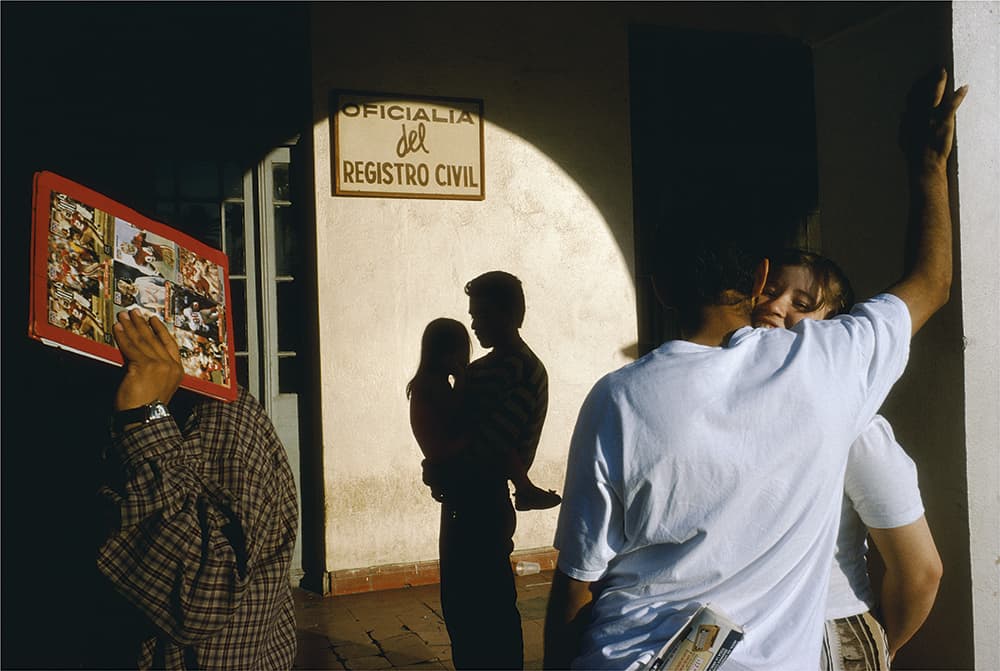
Tehuantepec, Oaxaca, 1985 – a good example of Webb’s visually layered compositions. All images Alex Webb/Magnum Photos
In 1975, Alex Webb made two critically important trips that changed his life as a photographer, and, as he says, perhaps as a human being as well. Webb went to the US-Mexico border and to Haiti. Those two trips opened up the possibility of other worlds to the young photographer.
Geographically and socially, these countries were worlds apart from New England, in the north-east of the USA, where Webb was raised. He has now wandered the world for more than 30 years, adopting a style of photography and awareness that is uniquely his own. In fact, it’s only recently that he, by own admission, has managed to discover new and interesting photographs in his home country of the USA.
Before all this, Webb had become interested in the art of photography in high school and, in 1972, he met Magnum photographers Bruce Davidson and Charles Harbutt in New York. By 1974, Webb was working as a photojournalist and just one year later was made a fully fledged member of Magnum. The work that followed found him treading the familiar grounds of his upbringing, specifically small-town America.
What’s of particular note during this period is that Webb’s images were in black & white, a complete juxtaposition to the work for which he is now famous. But then, juxtapositions are the kind of thing that Webb’s images are notable for.
This move from black & white was fairly political and philosophical in nature. It wasn’t just about a desire to try something new; it was about seeing the undercurrents of the world differently. Life, Webb points out, is not black & white. Social situations are not black & white. Politics are not black & white. Black & white suggests a world of clear distinctions, but life isn’t like that. By moving into colour, Webb was forced to see the world, its history and its multiple structures differently.
On the street

Nuevo Laredo, Tamaulipas, 1996 – vivid bursts of colour pop in the strong Mexican light
In La Calle, we find the fruits of a journey that began in 1975 and concluded (as much as journeys such as this have a concrete finale) in 2007. Every one of these images was taken on the streets of Mexico (‘la calle’ translates from Spanish to English as ‘the street’) and is perhaps the most perfect expression of Webb’s aesthetic and philosophical approach to his subjects as you’re likely to find (although also worth exploring is the retrospective tome The Suffering of Light). That approach is open to debate. It’s a visual and theoretical underpinning that’s both risky and courageous.
First, the visuals. Webb’s images are stacked, chaotic, almost maddening. They’re juxtaposed, layered, bursting palettes of colour, light and deep, dark shadow. Webb stacks the fore, middle and background of his frames to within an inch of their structural integrity. Flicking through the book feels almost like nervously looking at a suitcase that’s on the verge of bursting open and covering the walls in your clothes. They’re dizzying to look at sometimes, but once the initial visual vertigo has passed, once your eye has acclimatised to Webb’s way of seeing the world, you’ve got to admire his gumption. Not for nothing did photographer Dayanita Singh refer to Webb’s images as ‘migraine photographs’.
‘It’s not that just that, that and that exist,’ says Webb. ‘It’s that they all exist in the same frame. I’m looking for something more. You can take in too much; perhaps it becomes total chaos. I’m always playing along that line: adding something more, yet keeping it short of chaos.’

Oaxaca, Oaxaca, 1982 – the interplay of light and shadow are key marks of Webb’s work
So if Webb’s images embrace complexity and confusion, does that affect what neat little genre box we try to fit his work into? Of course it does. Webb’s images are not strictly speaking of Mexico.
It’s more that they’re from Mexico. The writer Geoff Dyer makes a good point when he says, ‘Wherever he goes, Webb always ends up in a Bermuda-shaped triangle where the distinctions between photojournalism, documentary and art blur and disappear.’ Sometimes within the same frame, staged events sit beside candid moments, creating a tension that is as admirable as the visual layering. Webb’s work occupies a strange territory. It’s both fact and fiction. In this way, perhaps we get closer to a truth than any straight document could.
SCORE: 5 out of 5

Published by Aperture
Price £26, 156 pages, hardback
ISBN 978-1- 59711-371-7








